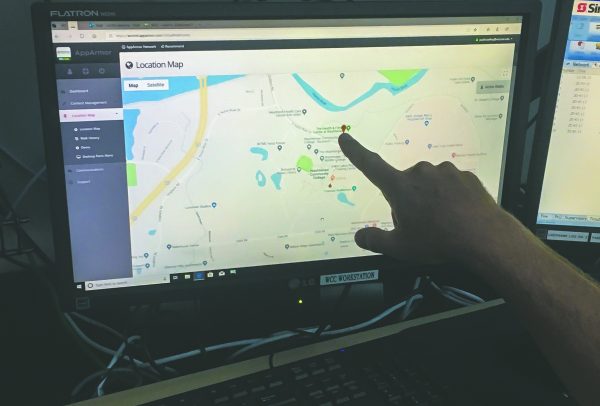
Scott Hilden, chief of public safety, demonstrates how the Virtual Walkhome feature works on the new campus safety app. Lilly Kujawski | Washtenaw Voice
| WCC Safe app features |
|
By Lilly Kujawski
Editor
This summer, the WCC Public Safety department launched a smartphone application branded “WCC Safe.” The app is intended to promote campus safety, strengthen the lines of communication between students and public safety officers, and provide services to better keep students safe, both on and off campus.
“We’re always looking for better ways to communicate and engage with the community,” said Scott Hilden, chief of public safety at WCC. “Our focus really is customer service.”
WCC is not the first college in the area to use a public safety app—the University of Michigan has a similar one available for its student body. However, WCC’s app is unique because of the Virtual Walkhome and Friend Walk features it offers.
Through the app, users walking on or off campus can request location-aware safety monitoring via live GPS. Campus safety officers will monitor on-campus activities during regular hours, while friends and family can monitor off-campus or after regular hours.
Using the “Virtual Walkhome” feature, a public safety officer will monitor on-campus trips until the user reaches their destination and alerts the officer that they’ve arrived safely. If at any point during their walk the user needs help or feels unsafe, they can tap the “emergency” button on the app, which will immediately alert public safety.
Public safety officers will also be alerted if it’s taking someone an unusually long time to reach their destination. The “Friend Walk” feature works similarly, except it alerts a designated friend or family member if anything goes wrong.
Students also have the option to trigger a “Mobile BlueLight” on the app, which sends the user’s location to public safety while simultaneously calling dispatch.
It’s important to note that public safety only monitors WCC campus, so using GPS services that request campus safety attention is not available when a student is off-campus. If an emergency situation occurs away from campus, dial 911 instead.
The WCC Safe app can also be used to report tips and concerns to public safety. Users can fill out an in-app form, call public safety directly or by use a chat box to speak with an officer.
“What we are trying to constantly communicate throughout campus is that, if you see something, please say something,” Hilden said. “It is the responsibility of everybody on this campus to contribute to the safety of this campus and the way you do that is when you see behavior that potentially is bad or dangerous, that you immediately report it to the public safety department, so that we can ensure the safety of everyone.”
“You don’t have to necessarily get involved, but by being an active bystander, you can communicate the concerns directly to us,” he added. “It’s not about being a snitch; it’s about doing the right thing.”
In the age of smartphones—97% of college students own one, according to a 2017 study from the Educause Center of Analysis and Research—Hilden hopes the app will reach students through a platform to which they relate.
“This application gives you another avenue to communicate to us,” Hilden said.
The app is a product of the AppArmor company, but personalizations and modifications to the software were tailored by the WCC public safety officers to meet the specific needs of WCC.
The idea to implement the app came from Hilden about a year ago, but he said the process and design has been a team effort from the entire public safety department.
Hilden said the public safety team aims to build a strong relationship with students so they feel comfortable communicating with the officers, and are not intimidated by them; he hopes this new app can help with that.
“I don’t want students to have to worry about being safe here, that’s our job,” Hilden said. “But when they do see something, helping contribute to that safety is important.”
The app also serves as a way for public safety to communicate emergency alerts to the student body.
The cost of the WCC Safe app was packaged with an internal “crisis team” application which is used by WCC administrators, according to Hilden. The combined cost of the two is $9,996 per year.
The WCC Safe app is available for free on Apple’s App Store and Google Play.


